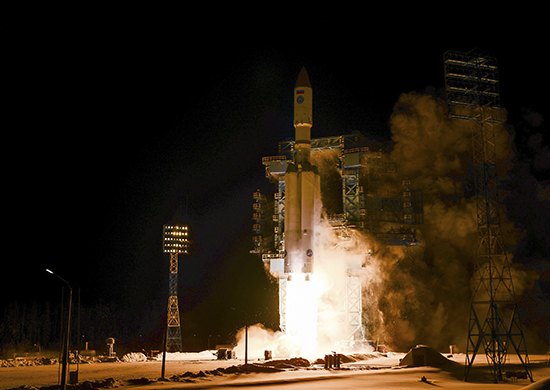
The third test launch of Russia’s heavy-lift Angara A5 rocket Dec. 27 was marred by an upper stage failure that stranded a dummy payload in a low orbit.
The Angara A5 rocket launched from the Plesetsk Cosmodrome, located in Russia’s Arkhangelsk region about 500 miles (800 kilometers) north of Moscow, at 2 p.m. EST (1900 GMT) on Dec. 27, according to Russia’s Ministry of Defense.
Liftoff occurred at 10 p.m. Moscow time to begin the third test flight of Russia’s heavy-lift Angara A5 rocket, following successful demonstration launches in 2014 and 2020.
The rocket’s five RD-191 engines collectively generated more than 2 million pounds of thrust to power the Angara A5 off the launch pad at Plesetsk.
Heading downrange east of Plesetsk, the rocket surpassed the speed of sound and jettisoned its four strap-on booster engines nearly three-and-a-half minutes into the flight. Then the rocket’s core stage, which fired its RD-191 engine at a lower throttle setting in the early phase of flight, powered up to full throttle to continue climbing into space.
The core stage switched off its engine and dropped away from the Angara’s third stage nearly five-and-a-half minutes after liftoff. A kerosene-fueled RD-0124 engine ignited on the third stage and fired for nearly seven minutes.
The Angara’s payload fairing jettisoned early in the third stage burn, revealing the rocket’s dummy payload after climbing into space.
The rocket then deployed a Persei, or Perseus, upper stage to perform a series of engine burns to maneuver into an orbit near geostationary altitude more than 22,000 miles (nearly 36,000 kilometers) above Earth.
A first burn was expected to accelerate the Persei stage into a parking orbit. That engine firing apparently concluded as planned.
But the upper stage did not conduct the additional engine burns needed to climb into a higher orbit. U.S. military tracking data showed the Persei upper stage, with its satellite mock-up payload presumably still attached, in a low orbit between 110 miles and 124 miles (177-by-200 kilometers) in altitude, well short of the mission’s target.
The orbit’s track was tilted at an angle of 63.4 degrees to the equator, according to radar tracking information obtained and published by the U.S. military.
The Russian Ministry of Defense confirmed the Angara A5 rocket’s blastoff from Plesetsk, but Russian officials provided no additional updates on the progress of the Persei upper stage.
The Persei stage is a modified version of the Block DM upper stage used on more than 200 Russian launches since 1974. The Angara A5 test flight Dec. 27 was the first use of the new Persei upper stage variant.
The first two Angara A5 test flights used Breeze M upper stages to place dummy payloads close to geostationary orbit. The Persei upper stage uses a different propellant mix — kerosene and liquid oxygen — than the hydrazine-fueled Breeze M.
The impact of the Persei stage failure on the Angara program was not immediately clear. But the Angara A5’s boosters, core stage, and second stage all apparently functioned as designed Dec. 27.
The expendable Angara rocket family is designed to fly in several different configurations, depending on the mass of its payload and the targeted orbit.
The Angara A5 can place up to 24.5 metric tons — about 54,000 pounds — into a 120-mile-high (200-kilometer) orbit. On missions with communications satellites heading for geostationary transfer orbit, an Angara A5 rocket can lift up to 5.4 metric tons, or about 11,900 pounds, according to Khrunichev State Research and Production Space Center, the Angara’s prime contractor.
The Russian government gave the green light for development of the Angara rocket in 1992. After Khrunichev won the contract to design and build Angara, the Russian government stated the rocket should begin operations by 2005.
But funding difficulties repeatedly delayed the Angara program. Finally, in 2014, Russia performed the first two Angara test flights.
A single-core prototype of the light-class Angara 1.2 rocket — designed to loft smaller satellites — flew on a suborbital test flight in July 2014. The Angara A5 rocket debuted in December 2014, also successfully.
At that time, Russian officials said multiple Angara test flights were scheduled before the rocket was to become operational in 2020.
Russia did not meet that schedule. Since 2014, officials have opened a new Angara production facility in Omsk, Russia.
The Angara burns cleaner fuel than the Proton rocket it will replace, which consumes toxic hydrazine and nitrogen tetroxide propellants.
Russian workers are building a new Angara launch pad at the Vostochny Cosmodrome in Russia’s Far East. Roscosmos, Russia’s space agency, said Dec. 27 that the launch pad at Vostochny will be completed next year, in time to host the first Angara launch there in 2023.
Russia’s medium-lift Soyuz rocket has launched from Vostochny, Russia’s newest spaceport, since 2016.
Once operational, the Angara A5 rocket will allow Russia to move some of its space launches from the Baikonur Cosmodrome, which the Russian government leases from Kazakhstan, to spaceports on Russian territory.
Email the author.
Follow Stephen Clark on Twitter: @StephenClark1.
